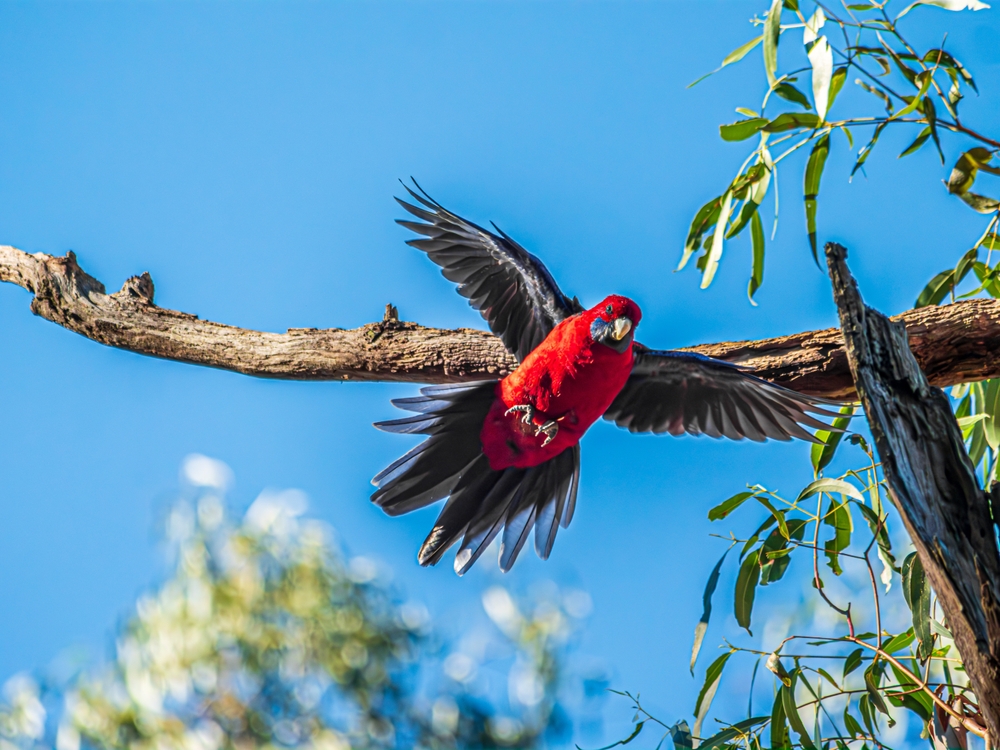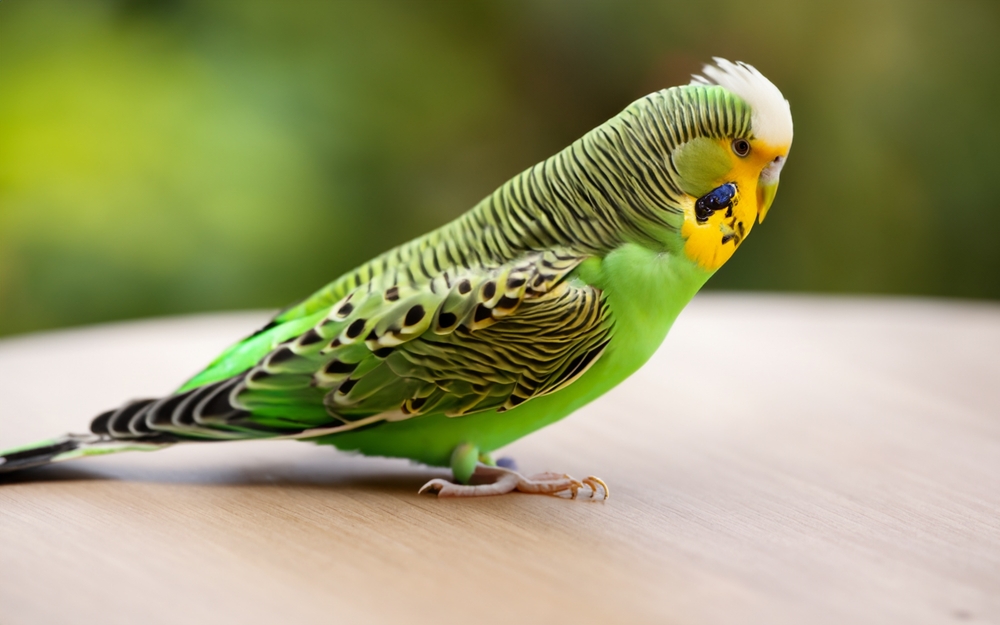Its closest relatives are other rosellas in the genus Platycercus, particularly the Yellow Rosella (Platycercus flaveolus)and Adelaide Rosella (Platycercus adelaidae), which are considered regional color variants or subspecies of the Crimson Rosella.
About
The Crimson Rosella (Platycercus elegans) is a vividly colored parrot belonging to the Psittaculidae family, native to eastern and southeastern Australia, including Tasmania. Its brilliant red plumage, offset by blue cheeks and wings, makes it one of the most striking parrots of the Australian landscape. Several subspecies exist, displaying variations in color such as yellow or orange, but all share the same elegant form and lively demeanor.
Measuring about 36 centimeters (14 inches) in length, including its long tail, the Crimson Rosella is a medium-sized parrot. Adults are predominantly bright crimson with contrasting blue cheeks, wing edges, and tail feathers, while juveniles are usually greenish before molting into their full adult colors. Its strong, curved beak is well adapted for cracking seeds, nuts, and fruits.
Crimson Rosellas are highly adaptable, inhabiting forests, woodlands, gardens, and parks. They are often seen in pairs or small groups but can gather in larger flocks when food is plentiful. Their diet consists of seeds, berries, nectar, insects, and blossoms, making them important seed dispersers within their ecosystems. In urban areas, they are frequent visitors to feeders and are beloved by bird enthusiasts for their striking appearance and sociable behavior.
Breeding usually occurs in spring and summer, with pairs nesting in tree hollows. Females lay four to eight eggs and incubate them while the male provides food. Once hatched, both parents care for the chicks until they fledge. The species is monogamous, and pairs often remain together for many years.
The Crimson Rosella is not considered threatened and is abundant throughout much of its range. Its adaptability to human-altered landscapes, along with its beauty, has ensured its continued presence in both wild and urban environments.
Physical Characteristics
The Crimson Rosella is a medium-sized, vividly colored parrot native to eastern and southeastern Australia, known for its striking plumage and graceful flight.
Plumage: Adults display brilliant crimson-red plumage on the head, breast, and underparts, contrasting with bright blue cheeks and shoulders. The back and wing coverts are deep red with black scalloping. The flight feathers and tail are a rich royal blue, with paler blue underwing coverts visible in flight. Several regional color morphs exist, ranging from yellow to orange forms, but the crimson variety is most iconic. Juveniles are greener, providing camouflage, and gradually molt into adult colors.
Head & Beak: The head is rounded with a pale grayish-white beak, strong and curved for cracking seeds. The eyes are dark brown, set against the vivid facial plumage.
Body & Wings: The body is slender yet robust, with long wings adapted for swift, direct flight through forests. The long, graduated tail enhances maneuverability and balance.
Size:
-
Length (Body and Tail): 12–14 in (30–36 cm)
-
Wingspan: 17–20 in (43–50 cm)
-
Tail Length: 6–7 in (15–18 cm)
Weight:
-
Adult Male: 4.9–6.3 oz (140–180 g)
-
Adult Female: 4.2–5.6 oz (120–160 g)
The Crimson Rosella’s brilliant red plumage, blue highlights, and melodic calls make it one of the most easily recognized and admired parrots of Australia’s woodlands and gardens.
Reproduction
The reproductive cycle of the Crimson Rosella follows the seasonal rhythms of southeastern Australia, with breeding linked to spring and early summer when food is plentiful.
1. Mating and Courtship:
Crimson Rosellas are monogamous and often form long-term pair bonds. Courtship includes mutual preening, feeding displays, and synchronized flights. Males court females by offering food and performing soft vocalizations.
2. Breeding Season:
Breeding occurs mainly from September to January, coinciding with the warmer months and abundant seed, fruit, and flower resources.
3. Nesting:
Nests are located in tree hollows, often high in eucalyptus or other tall forest trees. The female prepares the nest base with wood dust or decayed matter. Competition for hollows with other parrots and invasive species can be intense.
4. Egg Laying and Incubation:
The female lays 4–8 eggs, which are smooth, white, and rounded. Incubation lasts about 19–21 days and is carried out solely by the female, while the male provides her with food at the nest entrance.
5. Hatching and Chick Development:
Chicks hatch blind, helpless, and covered in sparse down. The female broods them during the first week, after which both parents take part in feeding, regurgitating seeds, fruits, and soft plant matter.
6. Fledging:
The young fledge at around 5–6 weeks, leaving the nest but remaining dependent on the parents for another 2–3 weeks as they perfect their foraging and flight skills.
7. Sexual Maturity:
Crimson Rosellas generally reach breeding maturity at 2–3 years of age, once they achieve full adult plumage.
The Crimson Rosella’s reliance on tree hollows for nesting makes conservation of old-growth forests essential to its long-term breeding success.
Lifespan
The Crimson Rosella is a moderately long-lived parrot, with survival strongly influenced by habitat stability, predation, and human activity.
Lifespan in the Wild:
In their natural forest and woodland habitats, Crimson Rosellas live on average 15–20 years. Juvenile mortality is relatively high due to predation by raptors, snakes, and competition for nesting hollows, but adults that secure territories often live two decades or more.
Lifespan in Captivity:
With consistent food, veterinary care, and safe housing, Crimson Rosellas may live up to 25–30 years, and occasionally longer. Proper enrichment is important to maintain their mental and physical health in aviculture.
Threats to the Crimson Rosella:
-
Habitat Loss: Removal of mature trees reduces nesting hollows and food sources.
-
Predation: Raptors, snakes, and introduced predators such as cats and foxes prey on eggs, chicks, and adults.
-
Competition: Intense competition for nest hollows from other parrots and invasive species (e.g., Common Mynas, starlings) affects breeding success.
-
Disease: Psittacine beak and feather disease (PBFD) is a threat in both wild and captive populations.
Conservation Status:
The Crimson Rosella is widespread and listed as a species of Least Concern on the IUCN Red List. Its adaptability to gardens and urban parks has helped maintain stable populations, though local declines occur where old-growth habitats are lost.
Eating Habits
The Crimson Rosella is primarily a herbivorous parrot, with a diet shaped by seasonal changes in Australia’s forests and gardens.
Diet:
They feed on a wide range of seeds, fruits, nuts, berries, nectar, blossoms, and buds. They also eat insects and their larvae on occasion, particularly when feeding chicks. Common wild foods include eucalyptus seeds, acacia seeds, wattles, and native berries.
Foraging Strategy:
Crimson Rosellas forage both on the ground and in the canopy. On the ground, they pick grass seeds and fallen fruit, while in trees they feed on blossoms, buds, and ripening fruits. Their strong curved beak is well adapted for cracking seeds and husking fruits.
Feeding Behavior:
They are usually seen feeding in pairs or small flocks, but outside of breeding season may gather in large groups, sometimes mixed with other parrots. They are often noisy while feeding, using contact calls to stay in touch with flock members.
Crop Feeding:
Like other parrots, they store food in their crop, allowing them to eat quickly in exposed areas and then digest in safety. Parents also use crop feeding to regurgitate softened seeds and fruits for their chicks.
Seasonal Feeding:
Their diet shifts with the seasons: seeds and grass in dry months, nectar and blossoms in spring, and fruits and berries in summer and autumn. They also take advantage of cultivated crops, feeding on orchard fruits and grains near farmland.
The Crimson Rosella’s versatile diet and ability to exploit both wild and cultivated foods have allowed it to thrive in forests, woodlands, and increasingly in urban gardens.
Uniqueness
The Crimson Rosella is one of Australia’s most striking and recognizable parrots, notable for its brilliant coloration, adaptability, and cultural presence:
Brilliant Plumage: Its vivid crimson-red body, contrasting with bright blue cheeks, wings, and tail, makes it one of the most visually stunning parrots of southeastern Australia.
Regional Color Forms: While the “crimson” form is iconic, other subspecies display yellow or orange plumage, creating a colorful spectrum across different regions of Australia. These intergrade where ranges overlap, producing intermediate forms.
Distinctive Flight Call: Its ringing, melodious “cussik-cussik” call is a familiar sound in forests and gardens, often heard before the bird is seen.
Human Adaptability: Unlike some forest parrots, Crimson Rosellas have adapted well to human environments, frequently visiting bird feeders, orchards, and gardens while retaining strong wild populations.
Juvenile Camouflage: Young birds are mostly green, blending into foliage for protection from predators before molting into the brilliant adult coloration at about 15 months.
Ecological Role: By feeding on seeds, berries, and blossoms, they help disperse seeds and pollinate plants, contributing to forest regeneration.
Cultural Presence: Featured in Aboriginal stories and Australian art, Crimson Rosellas are also among the most commonly kept native parrots, admired for their beauty and gentle temperament.
The Crimson Rosella’s combination of dazzling plumage, adaptability, and cultural significance makes it one of the most unique and celebrated parrots in Australia.
Be the First to Share Photos of This Species.
FAQ’s
1. What is the closest species to the Crimson Rosella?
2. How does the Crimson Rosella compare to other parrots?
It is medium-sized compared to larger parrots like the Alexandrine Parakeet, but larger than budgerigars and lorikeets. Unlike lorikeets, which specialize in nectar feeding, Crimson Rosellas have a broader diet of seeds, fruits, and blossoms, and their brilliant red-and-blue plumage makes them among the most striking parrots of Australia.
3. What national parks provide the best opportunities to see a Crimson Rosella?
What national parks provide the best opportunities to see a Crimson Rosella?
-
Blue Mountains National Park, Australia – Common in eucalyptus forests and picnic areas.
-
Grampians National Park, Australia – Frequent in woodlands and mountain forests.
-
Kosciuszko National Park, Australia – Seen in alpine woodlands and lower valleys.
-
Tidbinbilla Nature Reserve (near Namadgi National Park), Australia – Well-known for close encounters.
-
Great Otway National Park, Australia – Regular sightings along forest trails and coastal woodlands.





































































